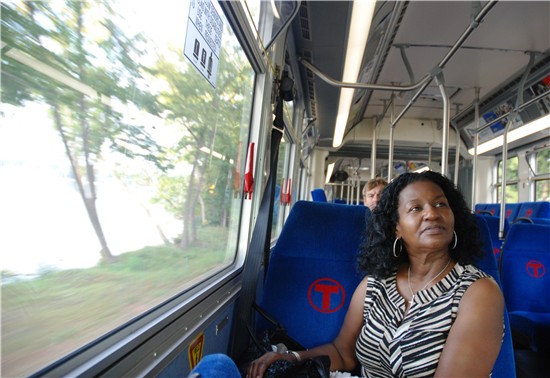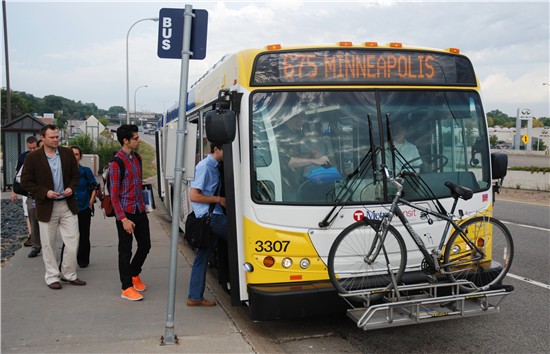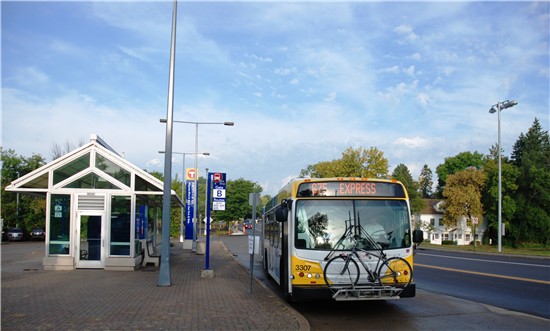
Visiting from Worcester, Mass., Mary Magnuson, James Cooper and David Barnett thought they’d take a cab from their hotel to downtown Minneapolis. Then they found a more cost-effective solution.
In the Twin Cities for a wedding, the trio hopped aboard an eastbound Route 675 bus that stopped right outside the Minneapolis Marriott West at Interstate 394 and Highway 169. They paid $2.25 a person instead of the $30-plus it would have cost to use a taxi.
“When I called the front desk and they told us how much it be, we quickly decided to take the bus,” Magnuson said after boarding and getting directions from the driver.
Other customers sharing the bus trip were a bit more familiar with Route 675, among the longest and oldest routes that Metro Transit operates.
Traveling between Mound Transit Center and downtown Minneapolis, Route 675 winds around the northern edge of Lake Minnetonka through Wayzata and Minnetonka, stopping at five Park & Ride lots on the I-394 corridor before bringing customers downtown.
In downtown Minneapolis, Route 675 buses use "Marq2" bus-only lanes, dropping customers off on 2nd Avenue South and picking them up on Marquette Avenue for trips headed to locations in the western suburbs.
On a recent eastbound, 8:08 a.m. trip, the 60-foot articulated ("accordion") bus filled with commuters as it made its way towards Minneapolis. While many commuters traveled downtown, customers also got off at Plymouth Road to go shopping or go to work and at Ridgedale Center to reach connecting rotes.
Kelsea Kern, 17, was among those who boarded at Mound Transit Center. The three-level municipal parking ramp, north of the Dakota Rail Regional Trail, opened in 2007 and includes 50 reserved spaces for Metro Transit customers.
 Kern drove 10 minutes from her home in St. Bonifacius and said she takes the bus nearly every day to get to Minneapolis Community and Technical College, where she is taking courses to earn early college credit.
Kern drove 10 minutes from her home in St. Bonifacius and said she takes the bus nearly every day to get to Minneapolis Community and Technical College, where she is taking courses to earn early college credit.
“This takes a little longer (than driving) but it’s a better use of my time because I can read and study along the way,” Kern said of her trip, which takes just over an hour. “It just makes a lot more sense.”
Kern was one of a handful of passengers who boarded in Mound. But the bus filled quickly as it made its way east, stopping at Wayzata Blvd. & Barry Ave. Park & Ride, Plymouth Road Park & Ride, Ridgedale Center, I-394 & County Road 73 Park & Ride ramp, General Mills Blvd. Park & Ride and Louisiana Transit Center in St. Louis Park.
The boardings add up: in 2012, more than 431,000 customers used Route 675, which operates between 5 a.m. and 9 p.m. on weekdays and on a slightly more limited schedule on weekends.
Deon Williams, who boarded at the I-394 & County Road 73 Park & Ride, is among those who ride on a regular basis. Williams said she has used Route 675 for the last year to get to her job in downtown Minneapolis, taking the bus to avoid traffic, read and catch up on work.
“With three kids at home, this is really the only time I can do it,” Williams said. “What I tell everyone is that this is my quiet time.”
The east-west service from the western suburbs is hardly new, either. Buses began running along Highway 12 as early as the 1920s as small bus companies sought to bring transit to the outer rings of the Twin Cities. The service was the first to be assumed by the Metropolitan Transit Commission (MTC) when it was created in 1967.
After I-394 was built in the 1980s, Route 675 buses began running a more circuitous route along frontage roads. More direct service is now provided by complementary Route 677, which runs between Mound and Plymouth Road Park & Ride then continues non-stop to downtown Minneapolis. Due to the fewer number of stops, trips on Route 677 take roughly 20 minutes less end-to-end than Route 675.
 Route 675 At a Glance
Route 675 At a Glance
Type: Express
Service: Route 675 buses travel between Mound Transit Center and downtown Minneapolis with stops at five regional Park & Rides – Mound Transit Center, Wayzata Park & Ride, Plymouth Park & Ride, I-394 & County Road 73 Park & Ride, General Mills Blvd. Park & Ride and Louisiana Avenue Transit Center. Buses operate from approximately 5 a.m. to 11 p.m. Monday through Friday and more limited hours on weekends. Trips are available roughly every half hour between Ridgedale Center and downtown Minneapolis; service on the far west end of the line runs approximately every hour. Buses use managed lanes, the I-394 MnPASS lanes and bus-only should to speed commutes. Downtown, buses use the Marq2 corridor and the PayExit system to speed boarding times.
Route length: Approximately 26 miles
Stops: 105 eastbound, 108 westbound
Vehicles: 60-foot articulated
Ridership: More than 431,000 customers in 2012, with an average of 1,178 customers per day.
History: Suburban bus service began in the Route 675 corridor in the 1920s, operated by Boulevard Transportation Company. It was the first service assumed by the Metropolitan Transit Commission when it was created in 1967. Buses originally made stops along Highway 12. When I-394 was built in the 1980s, buses began taking a more circuitous path that involved more frontage roads.
Future: I-394 is among eight corridors included in the Metropolitan Council's Highway Bus Rapid Transit Corridor Study. The study, due to conclude in early 2014, aims to determine how regular, all-day service similar to the METRO Red Line might work the corridor. A 2008 study that included input from the state, Metro Transit, communities along the corridor and other partners envisioned a continuous south frontage road along I-394 that could be used for such a service.